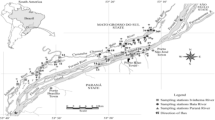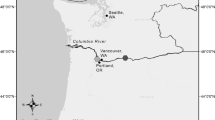Abstract
Ciliate epibionts inhabit aquatic systems globally and may exert negative impacts on their hosts. Evidence of the environmental drivers of these epibionts is lacking. This study aimed to test the effects of turbidity on the attachment success of the ciliate Epistylis sp. on the copepod Pseudodiaptomus stuhlmanni in the turbid St Lucia Estuary, South Africa. Epistylis sp. was exposed to P. stuhlmanni individuals for 24 h under six turbidity treatments (range 8–1,500 NTU). The prevalence and density of Epistylis sp. exposed to inorganic silt decreased significantly across the turbidity range in both runs of this experiment. In the natural silt treatments, prevalence increased with turbidity up to 500 and 250 NTU in the first and second experiment, respectively. Beyond these peaks, prevalence decreased. Density peaked at 250 NTU in both experiments. High prevalence and density in the natural silt experiments is directly related to the high organic matter content in this treatment. Association of Epistylis sp. with turbidity may impact negatively P. stuhlmanni, as the longevity of this copepod is negatively related to heavy cover by Epistylis sp. and to turbidity. These findings show that environmental factors may play a key role in modulating epibiotic interactions.




Similar content being viewed by others
References
Allen, Y. C., B. T. De Stasio & C. W. Ramcharan, 1993. Individual and population level consequences of an algal epibiont on Daphnia. Limnology and Oceanography 38: 592–601.
Anthony, K. R. N. & K. E. Fabricius, 2000. Shifting roles of heterotrophy and autotrophy in coral energetics under varying turbidity. Journal of Experimental Marine Biology and Ecology 252: 221–253.
Arruda, J. A., G. R. Marzolf & R. T. Faulk, 1983. The role of suspended sediments in the nutrition of zooplankton in turbid reservoirs. Ecology 64: 1225–1235.
Barea-Arco, J., C. Pérez-Martínez & R. Morales-Baquero, 2001. Evidence of a mutualistic relationship between an algal epibiont and its host, Daphnia pulicaria. Limnology and Oceanography 46: 871–881.
Carrasco, N. K. & R. Perissinotto, 2015. Zooplankton community structure during a transition from dry to wet state in a shallow, subtropical estuarine lake. Continental Shelf Research 111: 294–303.
Carrasco, N. K., R. Perissinotto & N. A. F. Miranda, 2007. Effects of silt loading on the feeding and mortality of the mysid Mesopodopsis africana in the St Lucia Estuary, South Africa. Journal of Experimental Marine Biology and Ecology 352: 152–164.
Carrasco, N. K., R. Perissinotto & D. Pillay, 2010. Zooplankton of the St. Lucia Estuary during the current drought cycle: a comparison between open- and closed-mouth conditions. Marine Ecology Progress Series 399: 157–171.
Carrasco, N. K., R. Perissinotto & S. Jones, 2013. Turbidity effects on feeding and mortality of the copepod Acartiella natalensis (Connell and Grindley, 1974) in the St Lucia Estuary, South Africa. Journal of Experimental Marine Biology and Ecology 446: 45–49.
Clamp, J. C., 1973. Observations on the host-symbiont relationships of Lagenophrys lunatus Imamura. The Journal of Protozoology 20: 558–561.
Dyer, D. C., R. Perissinotto & N. K. Carrasco, 2015. Temporal and spatial dietary dynamics of the longspine glassy (Ambassis ambassis) in the St Lucia estuarine system, iSimangaliso Wetland Park. Water SA 41: 95–97.
Fernandez-Leborans, G., 2010. Epibiosis in Crustacea: an overview. Crustaceana 83: 549–640.
Gilbert, J. J. & T. Schröder, 2003. The ciliate epibiont Epistylis pygmaeum: selection for zooplankton hosts, reproduction and effect on two rotifers. Freshwater Biology 48: 878–893.
Green, J., 1974. Parasites and epibionts of Cladocera. The Transactions of the Zoological Society of London 32: 417–515.
Green, J. D. & R. J. Shiel, 2000. Mobiline peritrich riders on Australian calanoid copepods. Hydrobiologia 437: 203–212.
Grindley, J. R., 1982. The role of zooplankton in the St Lucia estuary system. In Taylor, R. H. (ed.), St Lucia Research Review 256. Natal Sharks Board, Pietermaritzburg: 88–107.
Henebry, M. S. & B. T. Ridgeway, 1979. Epizoic ciliated Protozoa of planktonic copepods and cladocerans and their possible use as indicators of organic pollution. Transactions of the American Microscopical Society 98: 495–508.
Holland, R. S. & G. L. Hergenrader, 1981. Bacterial epibionts of diaptomid copepods. Transactions of the American Microscopical Society 100: 56–65.
Jones, S., N. K. Carrasco & R. Perissinotto, 2015. Turbidity effects on the feeding, respiration and mortality of the copepod Pseudodiaptomus stuhlmanni in the St Lucia Estuary, South Africa. Journal of Experimental Marine Biology and Ecology 469: 63–68.
Jones, S., R. Perissinotto, N. K. Carrasco & A. Vosloo, 2016a. Impact of a flood event on the zooplankton of an estuarine lake. Marine Biology Research 12: 158–167.
Jones, S., N. K. Carrasco, R. Perissinotto & A. Vosloo, 2016b. Association of the epibiont Epistylis sp. with a calanoid copepod in the St Lucia Estuary, South Africa. Journal of Plankton Research. https://doi.org/10.1093/plankt/fbw069.
McCabe, G. D. & W. J. O’Brien, 1983. The effects of suspended silt on feeding and reproduction of Daphnia pulex. American Midland Naturalist 101: 324–337.
Nhleko, J. B. B., D. P. Cyrus & L. Vivier, 2012. Diet of the demersal feeding Leiognathus equula in the Mfolozi-Msunduzi estuarine system, South Africa, in response to an impoverished macrobenthic invertebrate community. African Journal of Aquatic Science 37: 175–180.
Peer, N., N. K. Carrasco, R. Perissinotto & S. J. du Plooy, 2013. Flood effects on trophic linkages of selected fish species in the littoral zone of the St Lucia estuarine system. African Journal of Aquatic Science 38: 341–347.
Souissi, A., S. Souissi & J. S. Hwang, 2013. The effect of epibiont ciliates on the behavior and mating success of the copepod Eurytemora affinis. Journal of Experimental Marine Biology and Ecology 445: 38–43.
Stoecker, D., 1978. Resistance of a tunicate to fouling. The Biological Bulletin 155: 615–626.
Threlkeld, S. T. & R. L. Willey, 1993. Colonization, interaction, and organization of cladoceran epibiont communities1. Limnology and Oceanography 38: 584–591.
Utz, L. R. & D. W. Coats, 2005. Spatial and temporal patterns in the occurrence of peritrich ciliates as epibionts on calanoid copepods in the Chesapeake Bay, USA. Journal of Eukaryotic Microbiology 52(3): 236–244.
Utz, L. R. & D. W. Coats, 2008. Telotroch formation, survival, and attachment in the epibiotic peritrich Zoothamnium intermedium (Ciliophora, Oligohymenophorea). Invertebrate Biology 127: 237–248.
Visse, M., 2007. Detrimental effect of peritrich ciliates (Epistylis sp.) as epibionts on the survival of the copepod Acartia bifilosa. Proceedings of the Estonian Academy of Sciences: Biology, Ecology 56: 173–178.
Wahl, M., 1989. Marine epibiosis. I. Fouling and antifouling: some basic aspects. Marine Ecology Progress Series 58: 175–189.
Whitfield, A. K. & R. H. Taylor, 2009. A review of the importance of freshwater inflow to the future conservation of Lake St Lucia. Aquatic Conservation: Marine and Freshwater Ecosystems 19: 838–848.
Xu, Z. & C. W. Burns, 1991. Effects of the epizoic ciliate, Epistylis daphniae, on growth, reproduction and mortality of Boeckella triarticulata (Thomson) (Copepoda: Calanoida). Hydrobiologia 209: 183–189.
Zikhali, V., K. Tirok & D. Stretch, 2015. Sediment resuspension in a shallow lake with muddy substrates: St Lucia, South Africa. Continental Shelf Research 108: 112–120.
Acknowledgements
We are grateful to the iSimangaliso Wetland Park and Ezemvelo KwaZulu-Natal (EKZN) Wildlife conservation authorities for their support. We also thank Dr Sarah Bownes for providing us with the map of St Lucia (Fig. 1), and the postgraduate students from the University of KwaZulu-Natal (School of Life Sciences) who assisted with sample collections. This work is based on the research supported by the National Research Foundation of South Africa (NRF, unique Grant Nos. 94962 and 99441).
Author information
Authors and Affiliations
Corresponding author
Additional information
Handling editor: Mariana Meerhoff
Rights and permissions
About this article
Cite this article
Jones, S., Carrasco, N.K., Vosloo, A. et al. Impacts of turbidity on an epibiotic ciliate in the St Lucia Estuary, South Africa. Hydrobiologia 815, 37–46 (2018). https://doi.org/10.1007/s10750-018-3545-8
Received:
Revised:
Accepted:
Published:
Issue Date:
DOI: https://doi.org/10.1007/s10750-018-3545-8




